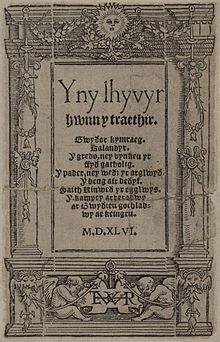|
John Prise
 Sir John Prise (also Prys, Price; Welsh: Syr Siôn ap Rhys) (1501/2–1555) was a Welsh public notary, who acted as a royal agent and visitor of the monasteries. He was also a scholar, associated with the first Welsh printed publication Yn y lhyvyr hwnn. He was a Member (MP) of the Parliament of England for Breconshire in 1547; Hereford October 1553; Ludlow April 1554; and Ludgershall November 1554.[1][2] LifeJohn was the son of Rhys ab Gwilym by Gwenllian, daughter of Howel Madoc, and was born in Brecon.[3] He was educated at All Souls College, Oxford,[4] and became a notary public and receiver of the king. From a statement of Rowland Lee, it appears that Prise had been some time in the service of the Earl of Arundel as constable of Cloon Castle in Ireland, and that for his employment he was promoted to be one of Thomas Cromwell's agents. In May 1532, when the Earls of Westmorland and Cumberland and Sir Thomas Clifford searched Cuthbert Tunstall's house at Bishop Auckland, Price looked into the manuscripts, and made a report to Cromwell. In 1533 he was employed under Cromwell. In 1534 he was registrar of Salisbury Cathedral. In April 1535 he took part in the proceedings against the Carthusians as to the royal supremacy. He officiated in the same way at the trial of John Fisher and Thomas More. He took part in the major visitation of the monasteries of 1535, alongside Sir Thomas Legh. When the Pilgrimage of Grace was quelled, he assisted in trying the rebels. For his services he received in 1537–38 a joint lease of Carmarthen rectory, and a lease of Brecon Priory and rectory. He also bought St Guthlac's Priory in Hereford. In a petition of 1538 he asked for the manor of West Dereham. He took part in public affairs, for example in the union of England and Wales, drafting or suggesting the petition on which the statutes were framed. He was Sheriff of Breconshire in 1541, and lived chiefly at Brecon Priory. He was knighted on 22 February 1547, served as knight of the shire for Breconshire in 1547, and made one of the council for the Welsh marches in 1551. He and his son Richard were patrons of Hugh Evans, and are said to have introduced him to Shakespeare; Richard gave Evans the living of Merthyr Cynog, Brecon, in 1572. Evans died in 1581, and made Richard Price the overseer of his will. He married Joan, daughter of John Williams of Southwark, and had a family of five sons and two daughters. WorksPrise was encouraged as a scholar by William Herbert, 1st Earl of Pembroke, and became a collector of manuscripts.[5] He wrote:
He is also said to have translated and published the Lord's Prayer, Creed, and Ten Commandments in Welsh, for the first time, in Yn y lhyvyr hwnn (1546). Modern editions
References
Further reading
|